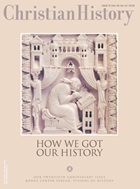Story time
Medieval historians assumed that their books would be read aloud, so they address their audiences as both "readers" and "hearers." One book, Ordericus Vitalis's Ecclesiastical History, even contains symbols indicating where the reader should make changes in the pitch of his voice while reading.
Learning by rope
While most cultures adopted some form of writing to keep their records, the Incas solved this knotty problem with knots. Their system, called quipu (or quipo) consisted of one long rope to which 48 secondary cords were attached; smaller cords in turn attached to these. The colors of the cords indicated their subjects, including land deals, economic figures, tribute accounting, and ceremonies. Knots represented ones, tens, and hundreds. Quipu did not preserve narratives, but it kept the Incan empire running smoothly at the national and local levels.
The dating game
Early Christian historians placed great importance in determining accurate chronologies. Historians in different regions calculated chronology independently, leading to contradictory liturgical practices (such as celebrating Easter on different dates) and confusion in comparing their histories. Later historians would even combine multiple chronologies in their historical works—Nennius's History of the Britons makes use of at least 28 different chronological systems. Bede was one of the first to use the anno Domini (A.D.) system, proposed by Dionysius Exiguus around 527, using the Incarnation as the central event from which all years are counted. Bede occasionally uses the designation B.C. (before the Incarnation) as well, but the B.C. count did not replace the old Roman system until the 1400s.
Retirement Age
When Christians had to find some way to account for the fall of the Roman Empire, many turned to Nebuchadnezzar's dream of the statue in Daniel 2 to explain the rise and fall of earthly empires. Following that biblical example, Christian historians created their own schemes of periodization. Augustine divides history into six stages that correspond to the six stages of the human life cycle, a system he seems to have appropriated from pagan philosophers such as Cicero and Seneca. According to his scheme, the coming of Christ marked the onset of humanity's old age.
The art of accounting
When written in cuneiform, even a farmer's accounting summary has aesthetic charm. This tally of sheep and goats displays Sumerian writing technique from around 2350 B.C. Though the subject matter seems mundane—as does most information recorded on extant cuneiform tablets—scholars of antiquity prize records like this as a window into the ancient Mesopotamian world.
Old-time religion
How old is Christianity? Pagans in the early church period scoffed that the upstart religion was too recent to be taken seriously, so early Christian historians, such as Eusebius, set out to prove them wrong. He proposed a chronology of world events that dated Moses' life and writings 400 years earlier than the Trojan War—the advent of Greek history and philosophy.
In the nineteenth and twentieth centuries, Christians faced a slightly different challenge as skeptics argued that the Bible was too recent to be taken seriously. The discovery of the Dead Sea Scrolls (fragment shown) in 1947 and following years greatly strengthened the Scripture's defense, enabling scholars to reconstruct the history of Palestine from the fourth century B.C. to A.D. 135 and show that New Testament accounts followed very closely behind the events they described.
Teaching texts
Lacking a linear sense of history, cultures of the Far East concentrated on communicating timeless ideas through stories. Their elaborately illustrated texts, such as this scroll of the Sri Bhagavata Purana with Sanskrit writing, mixed myths, legends, lives of great leaders, allegories, and chronicles of historical events in an attempt to explain the principles of religion to common people. The key lesson often centered on attaining virtue, through which a person could escape the cycles of history.
Copyright © 2001 by the author or Christianity Today/Christian History magazine.
Click here for reprint information on Christian History.

Support Our Work
Subscribe to CT for less than $4.25/month




























